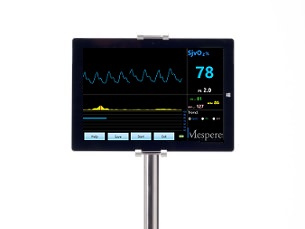VO 100
The Only Non-Invasive & Continuous Jugular Venous Oximetry Monitoring System

Breakthrough Transformation in Hemodynamic Monitoring
Mespere uses Near Infrared Spectroscopy (NIRS) technology to measure venous hemodynamics without the need for invasive catheterization.
Mespere non-invasive sensors shine near infrared photons into the tissue containing jugular venous blood vessels and analyze the diffusely reflected photons to determine jugular venous oxygenation.
VO 100 Jugular Venous Oximetry is ideal for use in:
- ICU
- Emergency
- Long Term Care
- Anesthesia


Clinical Applications:
- Sepsis early goal-directed therapy (EGDT)
- Cardiac output monitoring through Fick's Principle
- Fluid responsiveness prediction
- Cerebral tissue perfusion monitoring
Jugular Venous Oxygenation
| Features & Benefits | VO 100 System | FIBER-OPTIC CATHETER |
|---|---|---|
|
Accuracy |
✔ | ✔ |
|
Continuous Monitoring |
✔ | ✔ |
|
Non-Invasive |
✔ | |
|
No Risk of Infection |
✔ | |
|
Set-Up by Nurse |
✔ | |
|
Fast & Easy to Use |
✔ | |
|
Low Cost |
✔ |


VO 100 Jugular Venous Oximetry System |
||
|---|---|---|
| Description | Item Code | Qty |
|
VO 100 Sensor |
SEN-VO100 |
1 |
|
VO 100 Adhesives (Single Use) |
SA-VO100 |
25 |
|
Mespere Operating System |
OS-01 |
1 |
|
Mespere Display Monitor |
DM-10 |
1 |
|
Monitor Mount |
MM-01 |
1 |
For a PDF version, please download this document.
For more technical information about VO100, please read this document.
Physiology and Venous Oxygen Saturation
Venous oxygen saturation (SvO 2) is a measurement used to describe the balance between oxygen delivery and consumption in the brain. SvO 2 has been studied comprehensively, since it has shown to be an improved measurement over the traditional methods (heart rate, blood pressure and central venous pressure). Monitoring jugular venous oxygen saturation (SjvO 2) has been occurring for many decades and has shown to have useful clinical applications for neurosurgical procedures, cardiovascular procedures, head injuries, and sepsis patients.
Monitoring jugular venous oximetry allows clinicians to make more accurate adjustments, in order to improve the patient's wellbeing and will result in better long term outcomes.
Current Method
In the past monitoring involved the use of co-oximetry laboratory analysis and fiber optic technology. Currently the most common device used are fiber optic catheters. Fiber optic catheters are an invasive method. The Mespere VO 100 Jugular Venous Oximetry is a noninvasive continuous jugular venous oxygenation monitoring system, which uses near infrared spectroscopy to measure venous hemodynamics without the need for invasive catheterization.
Interpreting a Change in Venous Oxygen Saturation
The normal range for SjvO 2 is 60-80%, below 60% usually indicates that there is a low oxygen delivery, and above 80% indicates that there is low consumption. When monitoring a patient, clinicians should look for changes of ±5-10% for a period of 5 minutes of longer. If this occurs, that it is an indication of a change in oxygen consumption or demand 1. Jugular desaturation commonly occurs in patients with traumatic brain injury 2, cardiac surgery patients 3, and patients that are comatose.
References
- Frazier J., Theory and Clinical Application of Continuous Fiberoptic Central Venous Oximetry (ScVO2) Monitoring Edwards Lifesciences
- Roberson CS, Gopinath SP, Goodman JC, et al. SjvO 2 monitoring in head-injured patients. J Neurotrauma 1995;12:891-6
- Croughwell N. Warming during cardiopulmonary bypass. Ann Thorac Surg 1992;53:827-32
Accuracy of the Mespere VO 100 Jugular Venous Oximetry Compared to Catheters
Current risks involved with taking a SjvO 2 reading, are catheter placement and maintenance. Catheters are susceptible to conflicting results due to, the rate that the blood is withdrawn, head positioning, and correct tip placement 1. The current precision for commonly used fiber optic catheters, is ±4.41% 2. Contrary to fiber optic catheters, the Mespere VO 100 Jugular Venous Oximetry system is not susceptible to these risks since it is non-invasive, blood is not withdrawn and there is no placement or insertion of a catheter. The accuracy and precision of the Mespere VO 100 Jugular Venous Oximetry is ±2.00%, therefore it is more precise than the current SjvO 2 continuous monitoring methods.
Clinical Applications of Venous Oxygen Saturation
Monitoring jugular venous oxygen saturation (SjvO 2) has been occurring for many decades and has useful clinical application for neurosurgical procedures, cardiovascular procedures, head injuries, and sepsis patients. Continuous monitoring of venous oxygenation, has shown to be a valuable measurement for clinicians. It allows them to monitor the balance between oxygen delivery and consumption. The Mespere VO 100 Jugular Venous Oximetry is a non-invasive continuous jugular venous oxygenation monitoring system that is more accurate, precise, and has far less risks than most commonly used fiber optic catheters.
The Mespere VO 100 Jugular Venous Oximetry is ideal for use in Emergency Departments, Intensive Care Units and in Anesthesia.
References
- Holly C.G., Matta B.F., Lam A.M., Mayberg T.S., Accuracy of Continuous Jugular Bulb Venous Oximetry during Intracranial Surgery. J. Neurosurgical Anesthesiology 1995:7(3):174-7
- Mahajan A, et al. An Experiment and clinical evaluation of a novel central venous catheter with integrated oximetry for pediatric patients undergoing cardiac surgery. International Anesthesia Research Society 2006; 16:1257-63


